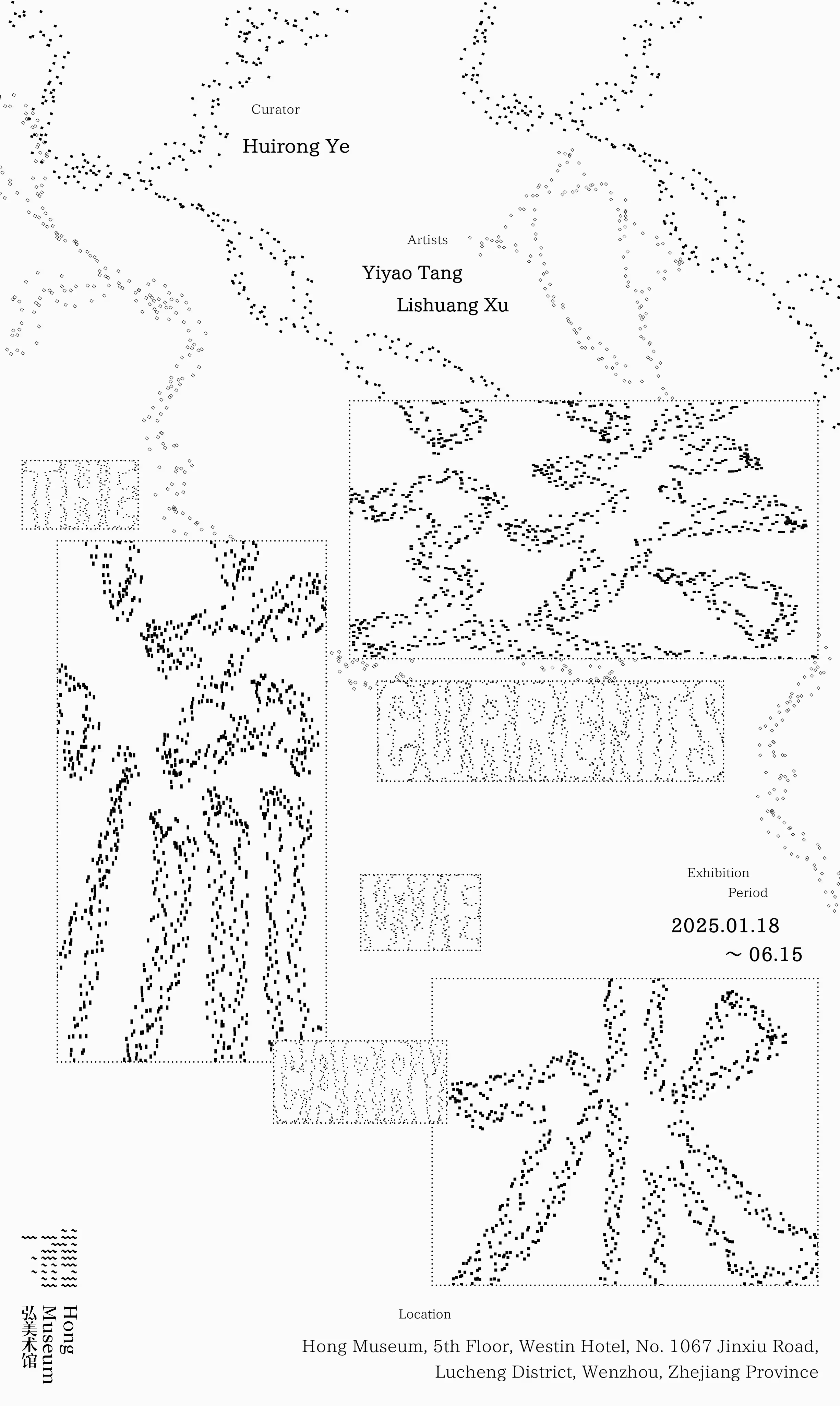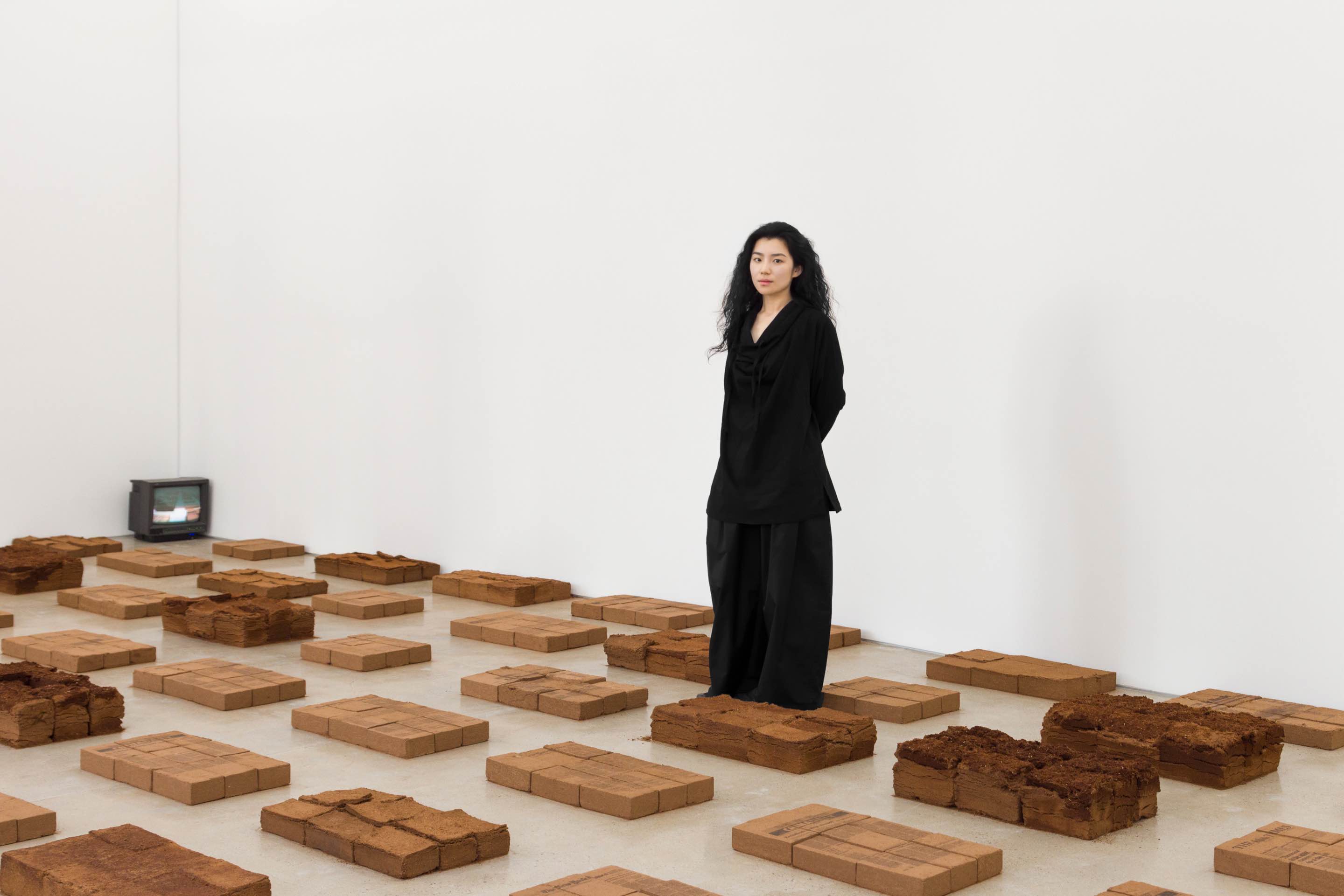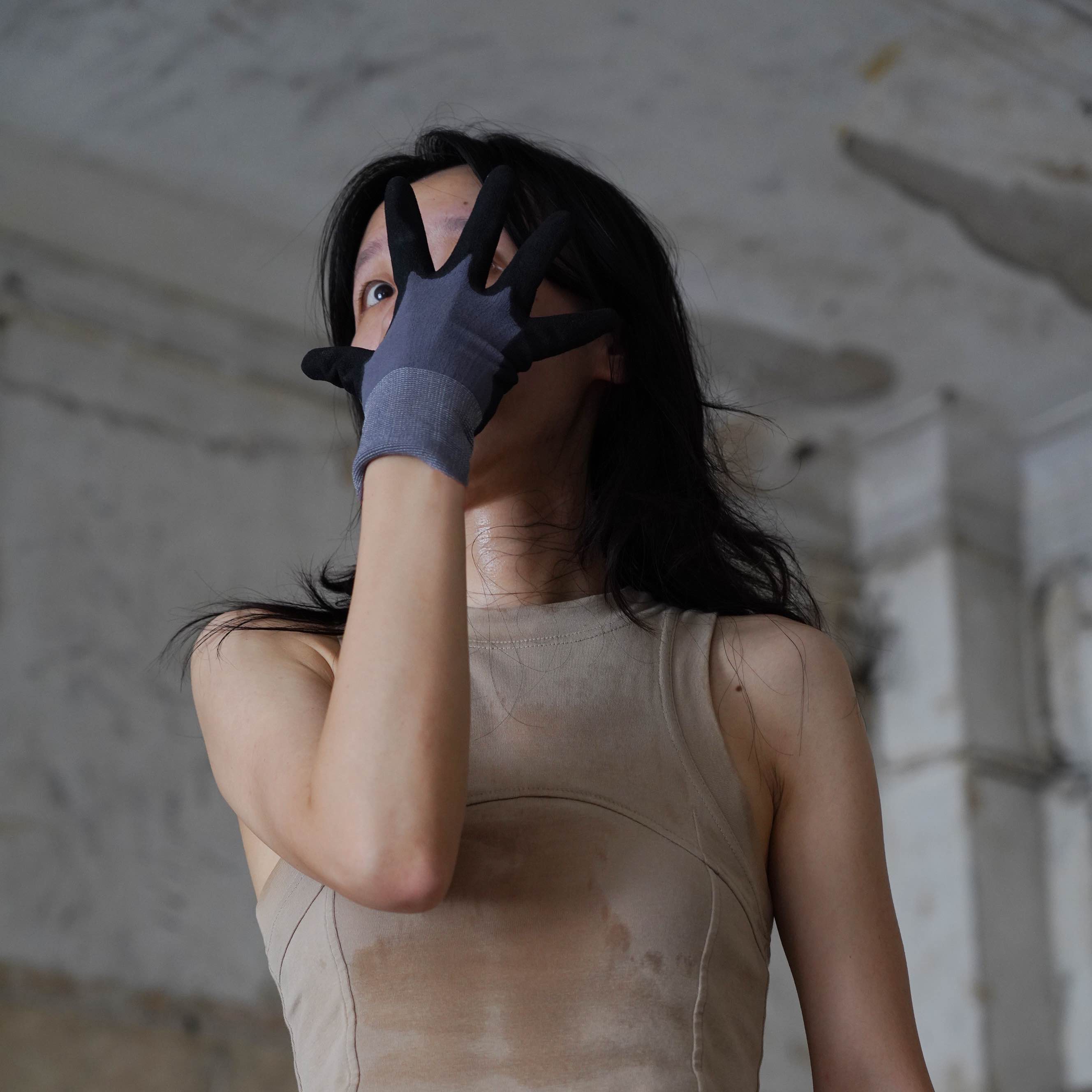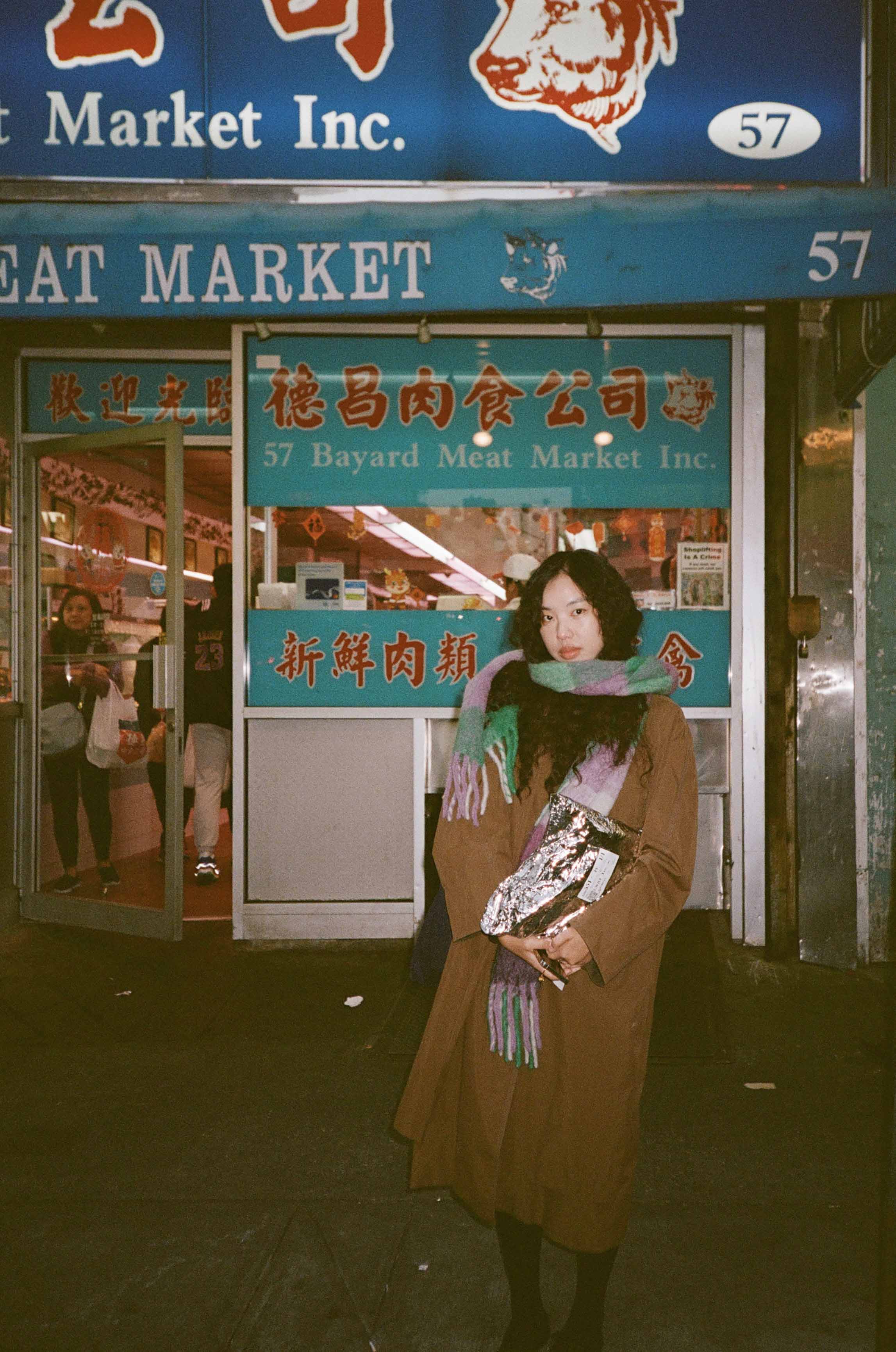
The Hong Museum presents The Currents We Carry, a dual exhibition featuring artists Yiyao Tang and Lishuang Xu, curated by Huirong Ye, and produced by Hongzheng Pan. Since the 1980s, the evolution of the "Wenzhou Model"—an economic framework defined by family-run businesses, private enterprises, and agile market mechanisms—has fostered a networked ecosystem of collaboration and production that transcends the boundaries of geography and identity through global trade systems. This exhibition engages with Wenzhou's distinct socio-economic landscape through works that navigate the imperceptible flow lines of industrial production, trace the imprints of exchange between laboring subjects and production spaces, and map the evolving contours of migration shifts, identity folds, and social flows.
、《摇摆,悬停》(2024)和《挤压、游移》(2024),弘美术馆_副本-min.jpg)
Exhibition view of The Currents We Carry, featuring Yiyao Tang’s sheltering, lingering (2024), swaying, hovering (2024), and compressing, expanding (2024)
The notion of "currents" in this exhibition refers to the operational flows intrinsic to industrial production lines. A hallmark of the industrial age, the assembly line is engineered to optimize the movement of materials while fixing workers into controlled, mechanical precision, thereby instituting a logic of production driven by the pursuit of maximum efficiency. This acceleration-oriented logic of material circulation extends into the transnational allocation of capital, technology, and labor, weaving diasporic networks that bridge Wenzhou's local industries with global systems. Simultaneously, "currents" metaphorically evoke the entrenched inertia of modernization—a relentless forward momentum where each leap intensifies circulation and reduces friction, yet obscures systemic ruptures and long-term consequences.
、《皮劳损耗》(2024)和《劳动改造》(2024),弘美术馆_副本-min.jpg)
Exhibition view of The Currents We Carry, featuring Lishuang Xu’s Value Added (2024), Wear and Tear I (2024), and Labor Reform (2024)

Yiyao Tang, permeating, collapsing; Lishuang Xu, From Factory to Museum (2024)
Both artists have rooted their practices in Wenzhou's local shoe manufacturing industry. Through participation in factory operations, material experiments, and ethnographic research, they examine how industrial systems shape and constrain bodies, labor, and agency, as well as the dual mechanisms of flow and control within capitalist structures. The arc-shaped gallery of the Hong Museum is conceived as a symbolic assembly line, where Yiyao Tang's works define its architectural and infrastructural framework, coaxing materiality into narratives and memories latent within its substance. Coconut coir bricks, rebar, and die molds—industrial products reimagined—are suspended in processes of continual generation and transformation, their material properties and embedded metaphors in constant flux. Bearing witness to the collective memory of industrial labor and the historical fractures of modernization, these works disrupt and confound fixed binaries: nature and artifice, stability and precarity, order and chaos.

Lishuang Xu, EUR-ŌU-PEAN CITY, Neon Light, Controller, 130 × 15 × 80 cm (2024)
》_单通道录像_1小时15分_2024_弘美术馆_副本-min.jpg)
Lishuang Xu, Backwards (Wenzhou), Single-channel Video, 1 hr 15 mins (2024)
Lishuang Xu addresses the themes of the body, velocity, and performance in a production-driven society. Through the paradoxical interplay of movements oscillating between efficiency and inefficiency, forward and backward, accumulation and expenditure, she archives, distills, and reconfigures the repetitive yet iterative motions of assembly lines, materializing labor scenes that are both tangible and spectral. In a culminating gesture, Xu "returns" a shoebox from the museum's display to a factory assembly line, bridging the spatial and conceptual divide between the industrial sphere of production and circulation of goods and the cultural realm of discourse and event-making. Visitors are invited to situate themselves within the exhibition's flows, becoming part of the fluid process of co-constructing meaning, while the unseen labor sustaining the museum's operations quietly lingers, awaiting recognition.

Yiyao Tang, molding, migrating, Rebars, Die Molds, Dimensions Variable (2024)

Detail of Yiyao Tang, compressing, expanding, Coconut Coir Bricks, Ink (2024)

Yiyao Tang, born in Wenzhou, China, in 1996, now lives and works in New York and Shanghai. She received her BFA from Pratt Institute in 2018 and her MA from Harvard University in 2023. Tang's practice coalesces mediums of intervention, projection, and installation to explore how social and political systems are embedded within images and objects. Using personal devices and inventive setups, she constructs and contests ideas on freedom, trauma, justice, otherness, and memory. Her setups behave twofold: both object and subject of her ideas, often leading to unpredictable outcomes themselves. More than just an archival account, Tang's approach approximates archaeology in her ongoing process of uncovering evidence of our own contemporary artefacts, collective memories, and climactic traumas.
Her solo exhibitions include: Faulting, Gallery Vacancy, Shanghai, 2024; Mattering, theBlanc Gallery, New York, 2023; Precarious, Kirkland Gallery, Cambridge, 2022. She is the recipient of the Cafe Royal Cultural Foundation Visual Grant, New York, 2024; the Bemis Center for Contemporary Arts Residency Program, Omaha, 2024; and the Swatch Art Peace Hotel Artist Residency, Shanghai, 2023.

Lishuang Xu is an artist based in Hunan and Shanghai. She graduated from the University of the Arts London (Chelsea College of Arts) with First Class Honours in BA Fine Art in 2019. Through performance, video, and installation, Lishuang Xu explores the unease of the body and perception in a rapidly changing society. Her work examines labour, spatial transformation, and performance systems. She draws inspiration from everyday actions and presents the entanglement of subjective perception and objective reality through alienation.

Hongzheng Pan is the founder and director of Hong Museum. He holds a M.Phil. in East Asian Studies from the University of Cambridge and a M.Sc. in Sociology from the London School of Economics. He is also a participant in the "Seeing the First 500 Meters" Mapping Workshop.

Huirong Ye is a researcher and writer whose work spans Sinophone art, film and visual studies, environmental humanities, transpacific island and ocean studies, sensory history, activist media, and epistemology. She seeks to redefine the dynamic relationship between text and image, exploring new narrative potentials at the intersections of historiography, ethnography, and representational media. Her research often transforms into lecture-performances, where she disseminates unfinished and unauthorized knowledge with passionate amateurism; evolves into essay films—currently focusing on storms, lighthouses, and socialist women's sky-watching groups; or takes the form of exhibitions, where she, as a curator, mediates the narratives and relationships between works by others. Ye graduated from the Harvard University Graduate School of Design and has lived and worked extensively between Boston and Shanghai. She is now constantly on the move.
Wenzhou is a city renowned for its high fluidity of population. Located in the heart of Wenzhou city, the Hong Museum stands as a beacon of artistic and social exploration. Its overarching goal is to rejuvenate and reinstate the interplay among art, social science, and the public by presenting and studying contemporary culture and art. We firmly believe that an art museum wields an essential influence in shaping society. As the embodiment of this vision, the museum serves as an entity, unifying the diverse facets of globalization and constructing a cultural institution that looks optimistically towards the future.